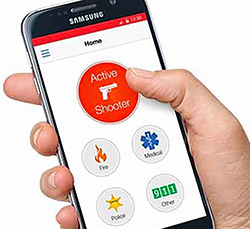Rave Mobile Safety sees double-digit growth rate continue Focus on communication and collaboration technology eyed as keys to success

By Cory Harris, Editor
Updated 10:44 AM CST, Wed February 17, 2021
FRAMINGHAM, Mass.—The year 2020 saw the issues of health and public safety thrust into the American spotlight. From the COVID-19 pandemic that still engulfs us in 2021, to the civil unrest around the country that brought the issues of racial injustice and police reform to the forefront, the response needed to address these and other critical public safety events was absolutely essential to mitigate these incidents.
 Enter Rave Mobile Safety, a Framingham, Mass.-based provider of critical communication and collaboration technology used to save lives, manage crisis incidents and increase resiliency. The Rave platform enables critical data sharing, mass notification and emergency response coordination for critical events from major disasters and crisis events to everyday emergencies and operational incidents.
Enter Rave Mobile Safety, a Framingham, Mass.-based provider of critical communication and collaboration technology used to save lives, manage crisis incidents and increase resiliency. The Rave platform enables critical data sharing, mass notification and emergency response coordination for critical events from major disasters and crisis events to everyday emergencies and operational incidents.
From ensuring 9-1-1 dispatchers have the best data to provide situational awareness to responders, to offering tools that enable collaboration for the immediate response to civil unrest, to solutions that effectively communicate the latest official information on COVID-19, Rave provided support to more than 8,000 first responders, emergency management, 9-1-1, and federal, state and local agencies, as well as corporations, healthcare organizations, universities and schools, in order to prepare better, respond faster, recover quicker and mitigate anticipated critical incidents.
It is this reliance on Rave’s solutions to address these life safety events that were instrumental in the company’s recent announcement that it reached its 11th consecutive year of double-digit revenue growth.
Government agencies, corporations and educational institutions, including the State of New Mexico Public Education Department, the Louisiana Governor’s Office and Department of Health, the City of San Francisco, Northwell Health and the University of Michigan, joined Rave’s collaborative safety ecosystem in 2020. Overall, Rave’s solutions were utilized in 38 million incidents representing billions of individual communications last year, a 68 percent increase over 2019.
Terri Mock, Chief Strategy and Marketing Officer, Rave Mobile Safety, told Security Systems News that safety and security are Rave’s mission. “If you think about all the types of incidents that are happening today, in terms of social unrest, school safety, the mental health of people working remote and perhaps going back to the office, how does that impact each person,” she said. “What could we be doing to make sure that wherever they are, they are being protected and they’re safe?
 “We work with various stakeholders in what we call a safety ecosystem. Those are the first responders, the 9-1-1 dispatchers, the covert security teams, the campus safety people and the school resource officers who are looking out for health and welfare. What we do is provide communication technology, collaborative technology, in order for them to respond when something happens, in terms of a crisis or an emergency. If you think about our tools and technologies, it’s all in support of the people who are trying to keep us safe.”
“We work with various stakeholders in what we call a safety ecosystem. Those are the first responders, the 9-1-1 dispatchers, the covert security teams, the campus safety people and the school resource officers who are looking out for health and welfare. What we do is provide communication technology, collaborative technology, in order for them to respond when something happens, in terms of a crisis or an emergency. If you think about our tools and technologies, it’s all in support of the people who are trying to keep us safe.”
Mock continued, “We’re very much mission driven; we really care about our first responders, we care about the emergency management people when we have a major flood or a major hurricane. They’re the ones who are figuring out how to evacuate vulnerable populations. Our technology provides the types of communication so that we, as the public or as a student, or as a parent or teacher, get the notifications of what’s happening.”
In addition to Rave expanding its ecosystem with new customers, the company expanded its applications to offer new solutions to advance cross-organizational collaboration amongst affected entities in a critical incident.
“How do these entities like 9-1-1, how are they talking to first responders?” she explained. “If you’re having a fire in an office complex, how is that corporate security team or facilities team collaborating or communicating with the first responders or the fire marshals on site? Our technology allows people to collaborate. These notifications that occur through our various tools can trigger many types of devices, including physical IoT [Internet of Things] devices such as desktop alerts, digital signage, public address systems, emergency sirens.
“There’s this connection so that if there’s an something’s happening in a school, and if there’s an active shooter incident, for example, the teacher can use the Rave Panic Button mobile app on their phone that triggers a notification to all the school leadership, maybe the school district leadership, and also straight to 9-1-1. Those seconds that are saved when that trigger goes straight to 9-1-1 dispatchers for police, fire and EMS to come on site, that allows for the saving of lives.”
Coronavirus Response
When asked about the contributing factors that led to Rave’s 11th consecutive year of double-digit revenue growth, Mock responded, “During times of crises, our tools were actually more in use. With the pandemic happening, a lot of state and local governments, a lot of companies, corporations and businesses really used our tools, in large effect, to communicate to the communities, to their workforce, as to the changes that were happening.
“We created, and we responded with offerings such as Rave Coronavirus Response Solution, which enhances organizations’ ability to monitor and quickly communicate changes about the ongoing pandemic to their communities. Then, as the coronavirus moved into different phases, such as the recovery phase, we then had an offering called the Rave Coronavirus Recovery Solution, which allows leaders to streamline communication workflows, conduct daily health checks, and supports individual wellness and engagement with their organizations to facilitate the safe reopening of businesses and communities.”
In addition, Rave introduced a Vaccine Distribution Solution, which aids in the coordination and communication of COVID-19 vaccine distribution plans based on community priorities, allowing users to identify priority candidates, keep their community informed about vaccine availability and track distribution progress. This involves individuals creating Rave’s Smart911 Safety Profiles for themselves and their families with pertinent health information.
“Any one of us can sign up for free,” Mock said of the Smart911 Safety Profile. “With that profile, you’re able to self-identify any medical conditions you may have, and this allows state and local agencies to identify people who should be given higher priority and notify them through our systems and say, ‘Hi, it’s time to come in,’ or ‘Hey, it’s time to get your second dose.’ It’s really been helpful to the various communities and hospitals using our tools.
Mock noted that Rave has “an ongoing technology focus, all for the purpose and mission of safety.” As another aspect of providing the right tools and capabilities in the midst of the pandemic, Rave launched a tool called Rave Collaborate, which provides an intuitive tool for tactical incident collaboration to coordinate preparedness and response for both planned events and unplanned emergencies, addressing needs unmet by traditional incident management solutions.
“It provides protocol on how to respond to any given incident, like the first thing that happens when the trigger of a panic button occurs - who needs to be notified, how to cordon off a neighborhood if that’s needed, so that you could protect the safety of those wanting to enter the zone,” she explained. “These are the steps that emergency managers and corporate security have for any given incident to respond. You are able to take those tasks, automate them, or at least document them into Rave Collaborate. It really prompts people in the spur of the moment, or heat of the moment really, to have guidance as to what to do and how to react.”
Mock added, “What has really helped us to continue growing is to address the needs of our customers, in terms of the challenges that they’re facing. Obviously, over the last year, there has been a focus on coordinating, collaborating and communicating about what’s happening with the pandemic.”
In addition to Rave’s coronavirus response, other factors that contributed to Rave’s revenue growth in 2020 included its response to social unrest, severe weather events, and critical community emergencies. “All of these events require the tools that we have to communicate and collaborate,” she said. “We are there for the first responders, for those officials who need to handle these emergencies.”
Survey Results
Rave recently fielded a 2021 Emergency Communication and Public Safety Trust Survey to understand some of the emergency communication challenges facing state and local agencies. The national survey of more than 1,000 American adults was conducted in December 2020 and January 2021.
The survey’s findings indicate that there is a general lack of trust in information the public receives from local officials. In fact, only 22 percent of respondents say they completely trust the information they receive from local officials.
Other survey findings show that first responders are more trusted than local officials, with 62 percent of respondents completely trusting information from firefighters and 59 percent completely trusting paramedics/EMTs.
That level of trust dropped for police, with only 33 percent of respondents saying they completely trust the information they receive from police.
In terms of vaccine distribution communication, only 37 percent of respondents said they are completely confident or very confident in their state’s ability to successfully distribute the vaccine.
The survey also showed that safety concerns are anticipated as people return to public spaces. Approximately 75 percent or more of respondents are either very or somewhat concerned about acts of violence as they return to congregating at public events like concerts and spaces like malls, schools and universities.
“We did this survey because we wanted to understand the level of trust in these communications because we work so much with these officials,” Mock said. “We just wanted to get more of an objective understanding of how the public sees this issue because it is very relevant today.”
Expanded Footprint
Rave added to its significant footprint of 3,500 public safety agencies and communities across all 50 states in 2020, as the Rave platform and Smart911 national safety registry were deployed by new cities and municipalities nationwide, including the Cities of San Francisco, New Orleans and Plano, Tex.
In Louisville, Ky., the Louisville Metro Emergency Services faced a challenging year between the pandemic, a fire on premise and ongoing local protests. The department turned to Rave’s solutions to combat a high call volume and push critical information to residents and visitors regarding COVID-19 restrictions. They also sent targeted notifications based on location to inform different groups about ongoing protests in their area.
Mock recognized Jody Meiman, Director for Louisville Metro Emergency Services, who utilized Rave’s text-from-911, proactive alerts and Smart911 Safety Profiles to provide the most informed response possible to the community.
“They were literally facing fires, the pandemic, social unrest,” she said. “In the midst of all of this, they were operating their Emergency Services Center and sending out notifications to targeted audiences in the city, saying, ‘Hey, there’s social unrest here. Don’t go here.’ He was using Rave technology to help in the crises they were facing.”
Rave expanded its growth into 1,600 enterprises and healthcare facilities confronted with the challenge to quickly notify, effectively engage and efficiently target critical communications to a distributed and remote workforce. Businesses and manufacturing facilities, such as Seaboard Foods, Sinclair Oil and LendingTree, use the Rave platform to proactively protect their workforce, and inform them of updated policies and resources for support.
Rave’s solutions are also deployed in the area of campus safety. Customers include 65 percent of the U.S. higher education population, five of the eight Ivy League universities, 10 of the 14 Big Ten schools and nine of the Big 12 schools, with those numbers growing in 2020 as colleges and universities nationwide navigated existing safety threats, along with new concerns brought on by the pandemic.
For K-12 schools, New Mexico joined Oklahoma, Delaware and Louisiana in 2020, becoming the latest state to deploy Rave Panic Button in all K-12 schools across the state, covering nearly 350,000 students. Overall, Rave Panic Button has been implemented in more than 10,000 schools across the U.S., including those in New York, Arkansas, Washington, D.C. and Florida.
“There is a lot of traction in terms of how we can prevent,” Mock said. “You have these tools in order to prevent, and then be there when it counts.”
Marketing Strategies
When asked what marketing strategies will be implemented to achieve a 12th straight year of double-digit revenue growth, Mock noted a continued focus on understanding the needs of customers of the communities and businesses that Rave works with.
“The survey is really to that effect,” Mock stated. “What is effective communication in crisis? What can be done to improve on that? We want to be spokesmen to talk about these types of issues.
“We also want to continue to grow and expand. That’s what drives us as an overall company. We’re looking for opportunities to expand any existing markets that we’re in.
She continued. “I think really our philosophy is if we take care of our customers, who are taking care of us, then all the rest will come. Sometimes it’s not the most complicated technology, it’s the most useful one. When you need to get an alert out, you need to do it fast. What is most useful to someone responding in a crisis? If it’s easy to deploy, easy to use, helps you in the heat of the moment and keeps your head straight, that’s what we’re after.”
Comments